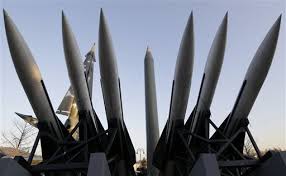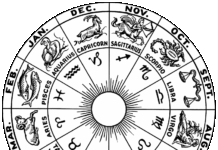The North Koreans have tested yet another potentially-intercontinental missile, this one reaching scant 1000 km before crashing into the sea. Not bad, some might say, for the impoverished country, but one uses the term ‘intercontinental’ with a grain of salt, for they have a long way to go yet. The distance from Pyongyang to Los Angeles is 9569 km, so any long-jong missile has to have another 8000 kilometres of juice before it can hit the continental U.S. Anchorage is 3000 km closer, but what’s the benefit of nukeing Alaska? For the U.S.-hating Kim Jong-Un, Beverly Hills makes a much more attractive target, in more ways than one. Aim right for the Hollywood sign..
I wonder why these nutty doomsday types bother with missiles, when it would be technically easier just to smuggle a warhead on board a ship or a truck, and detonate from a distance, or even while you’re sitting on top of it, like Slim Pickens in the final scene from Dr. Strangelove.
Either way, the damage would be, to understate the case, catastrophic. To grasp what effects such a bomb would cause, peruse accounts of the last time a nuclear bomb was detonated in war, on the morning of August 6, 1945, over Hiroshima, Japan, then three days later over Nagasaki on August 9th. According to reports, the two bombs killed 129,000 people instantly, men (including 20, 000 soldiers), women, children, and whatever unborn there were in both cities. Many more thousands died of radiation burns and poisoning in the days, weeks and years afterwards.
It was partly in response to these atrocities that the Pastoral Constitution on the Church, Gaudium et Spes, taught the following at the end of the Second Vatican Council in 1965, a teaching that was put into this form in the universal Catechism:
Every act of war directed to the indiscriminate destruction of whole cities or vast areas with their inhabitants is a crime against God and man, which merits firm and unequivocal condemnation.” A danger of modern warfare is that it provides the opportunity to those who possess modern scientific weapons especially atomic, biological, or chemical weapons – to commit such crimes (cf., GS, 80.3; CCC, 2314)
We should keep in mind that soon after the war, the United States and Russia developed hydrogen bombs, so-called thermonuclear warheads, based on nuclear fusion of hydrogen into helium (the same energy that powers the Sun and stars), many times more powerful than the initial atomic bombs, which get their power from the fission of heavy elements (such as uranium). Even a one-megaton hydrogen bomb (the atomic bombs dropped on Japan were in the kiloton range, ten times less powerful) could easily level the entire city of Manhattan, instantly killing many of its inhabitants, and there are bombs out there with five to ten times that power. And to ponder that this apocalytpic technology is now also in the hands of Britain, France, China, Pakistan, India, Israel, and, presumably, North Korea. Any one of them could in theory start a nuclear war, at least of limited extent.
One could think of a scenario where nuclear weapons could be morally justified, say, in destroying an enemy fleet in mid-transit across the Pacific, or even blowing up an asteroid a la Bruce Willis (an impossibility, by any physical standards). In any real life use, there is always the danger, if not usually the outright intention, of untold numbers of innocent collateral casulaties, that can never really full be removed, nor justified.
It was Albert Einstein’s Special Theory of Relativity, which he formulated way back in 1905, and its famous equation, E= mc2, that first predicted the bomb (as well as nuclear power, to give the good side of all of this). That is, the energy (E) in any particle of matter is equal to its mass (m) times the speed of light (c) squared. Now, the speed of light is a very, very big number (186,000 miles per second, squared). There is enough energy in the ‘mass’ of the atoms of a piece of paper to power a whole city. It’s just that it is practically inaccessible.
But the power of certain atoms, uranium, plutonium, hydrogen and such, is indeed ‘accessible’ with the right technology, and Einstein realized the potential ‘yield’ that could be derived from even a small amount of mass, but did not want to reveal it, for he knew what evil the power of the atom could unleash upon the world. And once that genie was out of the bottle, as we all too well know, there is no way to put him back in. He just roams around the world looking for someone to annihilate.
It was only when he discovered that the Nazis were working on technology to develop ‘the bomb’ that Einstein in 1939 penned a two-page letter to the then-President of the United States, Franklin D. Roosevelt, explaining the technology of “a massive nuclear chain reaction involving uranium (that) could lead to the construction of “extremely powerful bombs of a new type” — the atomic bomb”. Einstein figured it was better for the U.S. to have the bomb, rather than the Nazis. Or perhaps for both, the beginning of that unstable state of nuclear deterrence.
Thus began the five year top-secret Manhattan Project, the most ambitious and expensive research program not only in U.S., but in world history, with the best and brightest scientific minds dedicated to producing the most lethal weapon ever devised. As we know, the Germans never perfected the bomb, but America did, and hence we have Hiroshima and Nagasaki. And now the technology is in the hands of nutjobs and ideologues and who knows who else.
The question is: What next? Pandora’s box was opened on those fateful days in August, 1945 (the first, curiously, on the feast of the Transfiguration), but has remained closed ever since. God has His hand in all of this, and we should pray that the evil of nuclear weaponry, and all such means of indiscriminate mass destruction, remain quiescent and rusting away until Judgement Day, and then some…
Our Lady of Peace, ora pro nobis!












